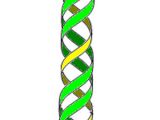 |
A group of researchers in Denmark is working on creating something entirely new on this planet – lifeforms that contain an improved version of the double-helix DNA. They are, for all intents and purposes, seeking to create stable, triple-helix deoxyribonucleic acid.
Since the acid was first discovered, experts have known that it features two strands, which dance around each other and form a distinctive, double-helix structure. All complex organisms contain DNA, and all of them feature variations of this configuration.
But the Danish team apparently finds this underwhelming, and is trying to introduce a third strand into DNA. They have already achieved success in their attempts, and they are currently engaged in solving some unforeseen problems that appeared as they created the “cyborg” DNA.
Since the acid was first discovered, experts have known that it features two strands, which dance around each other and form a distinctive, double-helix structure. All complex organisms contain DNA, and all of them feature variations of this configuration.
But the Danish team apparently finds this underwhelming, and is trying to introduce a third strand into DNA. They have already achieved success in their attempts, and they are currently engaged in solving some unforeseen problems that appeared as they created the “cyborg” DNA.
The group, which is based at the University of Copenhagen, wants to add a third peptide nucleic acid (PNA) strand to the two DNA strands that already exist in all organisms. The research team also has some well-grounded reasons for doing so.
One of the main functions the new PNA strand fulfills is block the activity of certain genes – such as for example those that have been associated with elevated risks of developing particular forms of cancer – and boosting the activity of other (that have been proven to be beneficial).
An added advantage that PNA has over DNA is that it's not limited by default to the four “letters” that DNA uses, G, A, T and C. The new strands can be fashioned from other chemicals than these four.
Researchers from the UC Center for Biomolecular Recognition (CBR) already managed to create a triple-helix structure, by inserting a PNA strand in between two DNA strands. But this move had an unexpected effect.
Rather than a single PNA strand being added to the standard, double-helix structure, two PNA strands forced one DNA strand out of the structure. The end result was a triple-helix containing 2 PNA and 1 DNA strand.
The excess DNA formed a P-shaped loop, which was demonstrated to play a role in making the entire structure replicate a lot faster than normal DNA is capable of.
The only problem with this form of genetic manipulation is that PNA is soluble in water. This means that the strands cannot function inside a human body, for example. The UC team is currently working on developing a means of water-proofing these strands.
Once they manage to do so, they will be able to create stable DNA-PNA triple-helix structures, that could be inserted in lab animals for further testing, Daily Galaxy reports.
One of the main functions the new PNA strand fulfills is block the activity of certain genes – such as for example those that have been associated with elevated risks of developing particular forms of cancer – and boosting the activity of other (that have been proven to be beneficial).
An added advantage that PNA has over DNA is that it's not limited by default to the four “letters” that DNA uses, G, A, T and C. The new strands can be fashioned from other chemicals than these four.
Researchers from the UC Center for Biomolecular Recognition (CBR) already managed to create a triple-helix structure, by inserting a PNA strand in between two DNA strands. But this move had an unexpected effect.
Rather than a single PNA strand being added to the standard, double-helix structure, two PNA strands forced one DNA strand out of the structure. The end result was a triple-helix containing 2 PNA and 1 DNA strand.
The excess DNA formed a P-shaped loop, which was demonstrated to play a role in making the entire structure replicate a lot faster than normal DNA is capable of.
The only problem with this form of genetic manipulation is that PNA is soluble in water. This means that the strands cannot function inside a human body, for example. The UC team is currently working on developing a means of water-proofing these strands.
Once they manage to do so, they will be able to create stable DNA-PNA triple-helix structures, that could be inserted in lab animals for further testing, Daily Galaxy reports.
Source: SOFTPEDIA

No comments:
Post a Comment